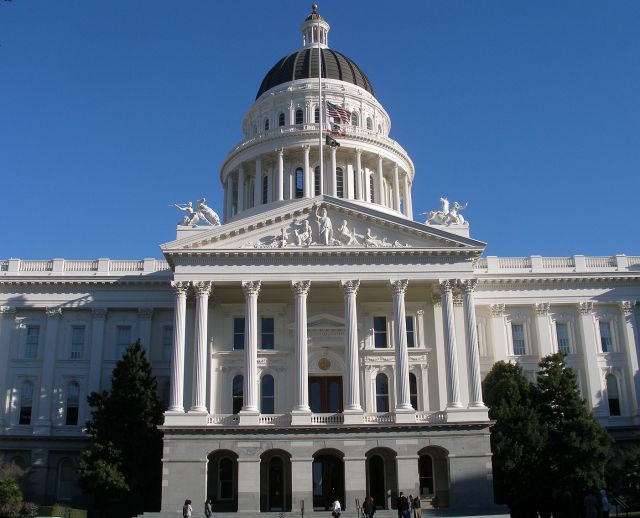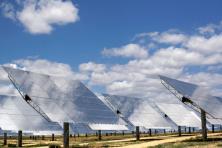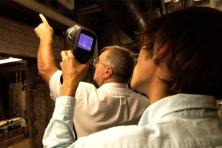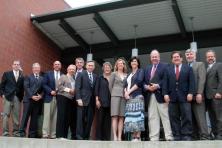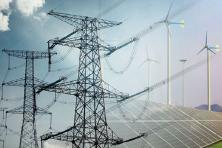In the absence of national climate and energy policy, US local and regional leaders are developing the climate and clean energy policies, strategies, and projects required to reduce carbon emissions and the state of California is the gold standard for climate policy leadership and community-supported clean energy innovation.
The state has set specific goals and targets, requires participation of cities in achieving those goals, and supports communities with specific, effective energy efficiency and clean energy programs.
Assembly Bill 32 (AB 32), which established a comprehensive program of regulatory and market mechanisms to reduce greenhouse gas emissions, has a Scoping Plan that spells out the roles and responsibilities of local jurisdictions in achieving reductions.[1]
Related state law SB 375 sets targets for low-carbon community development, with implementation strategies—especially in the transportation sector—to be negotiated with metropolitan planning organizations.
In support of community action toward these goals, the California Air Resources Board, California Energy Commission, and other state agencies developed an online climate action planning resource for local governments as part of CoolCalifornia.org.
This site’s local government webpage includes specific reports and tools for communities to inventory their greenhouse gas emissions, adopt targets for emissions reduction (specifically encouraging communities to set targets for years 2030 and 2050 that are consistent with the AB 32 statewide emissions reduction), develop climate action plans, implement policies, and monitor and track their progress.
California has a range of collaborative programs between state agencies and the state’s utilities that help communities meet their energy and carbon reduction goals. Energy Upgrade California is a statewide one-stop shop for residential and commercial energy efficiency retrofits, based on an “unprecedented alliance among California counties, cities, non-profit organizations, the state’s investor-owned utilities, and publicly owned utilities.”
Energy Upgrade California is a program of the California Public Utilities Commission (CPUC) and the California Energy Commission (CEC) in collaboration with those stakeholders, funded by utility ratepayers under the auspices of CPUC and an initial Recovery Act grant from the U.S. Department of Energy.[2]
Energy Upgrade California:
- Helps residential and commercial energy customers and building professionals understand currently available energy and water efficiency programs and financing options across state agencies and utilities;
- Provides a consistent message regarding how to select energy efficient measures and contractors to implement those measures;
- Drives consumers and contractors to a central resource with educational information on all of the state’s energy efficiency upgrade rebates and incentive offerings; and
- Educates the building trades and home improvement industry on jobs, training, and certifications.
California community leaders such as Sonoma County Energy Independence Program and the Western Riverside Council of Governments (both of which are national leaders in developing residential and commercial Property Assessed Clean Energy (PACE) programs) point to Energy Upgrade California as a key partner and resource for their efforts. Sonoma received a $5 million grant from the program to write a replication manual for other local governments based on its PACE program[3].
Energy Upgrade California also has a resource library that provides marketing materials, a speakers’ bureau, and tools for contractors, raters, municipal staff, and other stakeholders to support their energy efficiency programs.
Engage 360 is a multi-year statewide project of “inspiring and guiding Californians to achieve a 20 percent reduction in their home energy use by 2020,” through community events and grassroots outreach that educates residents, businesses, and industrial and agricultural producers about energy efficiency and conservation. It is funded by the CPUC and investor-owned utilities (IOU) and implemented by CPUC.
Go Solar California is a collaborative campaign of the CEC and CPUC intended “to encourage Californians to install 3,000 MW of solar energy on homes and businesses by the end of 2016, making renewable energy an everyday reality” and “to install 585 million therms of gas-displacing solar hot water systems by the end of 2017.”[4]
Its components are the California Solar Initiative, which includes solar systems and solar thermal systems in large IOU areas; the New Solar Homes Partnership, which focuses on solar systems on new homes in large IOU areas; and various programs implemented through publicly owned utilities. Together these programs cover all of California. The state also helps affordable housing customers access full or partial funding for solar energy and solar thermal systems.
In the state’s Long-term Energy Efficiency Strategic Plan, CPUC set ambitious energy efficiency goals for the state, including achievement of zero net energy new construction in the residential sector by 2020 and zero net energy new construction in the commercial sector by 2030.[5] Energy Upgrade California and the California Solar Initiative, mentioned above, are considered to be significant drivers of progress toward the goals, along with a zero energy homes design competition, installation of smart meters, the California Advanced Homes Program, and the Business and Consumer Electronics Program.[6]
The state also commissioned an energy efficiency financing report, released in July 2011, to address financing barriers to achieving these goals. These are not the only initiatives; for example, in southern California, the IOUs offer a Sustainable Communities Program that provides design/technical assistance, training, and other professional resources to new construction projects that incorporate sustainable practices on large-scale master planned projects as well as smaller-scale net-zero energy projects.
As with much of the history of American innovation, California is leading the way when it comes to climate and clean energy solutions.
[1] See the California Air Resources Board webpage on the role of local governments in implementing AB 32. In 2010, the Brattle Group consultancy released a report evaluating the impact of AB 32 on local governments, using the City of Chula Vista as a case study.
[2] The California Energy Commission is required under AB 758 to develop and implement a comprehensive program to achieve greater energy savings in California’s residential and non-residential building stock, building on the momentum of Energy Upgrade and other related Recovery Act-funded programs.
[3] One of the more noteworthy aspects of California’s clean energy efforts has been its continued embrace of Property Assessed Clean Energy (PACE) financing in spite of the Federal Housing Finance Agency’s proposed rules that would cripple PACE funding. For more information on this ongoing issue, see PACENow.
[4] California has long been a leader in renewable (and particularly solar) energy adoption, with legislation dating back to the 1990s. There were over 10 laws on solar distributed generation enacted in the 2007-2008 state legislative session alone, and six solar-related laws enacted in the 2009-2010 session.
[5] CPUC’s strategic plan was informed by CEC’s Integrated Energy Policy Report of 2007, which focused on how to expand the Commission’s efforts to reduce greenhouse gas emissions. The strategic plan encouraged investor-owned utilities to move away from “widget” based programs to “whole-house” approaches, in addition to a host of specific recommendations.
[6] CPUC released a progress report in October 2011 that describes how state and utility programs are working together to help achieve the net-zero energy goals.
